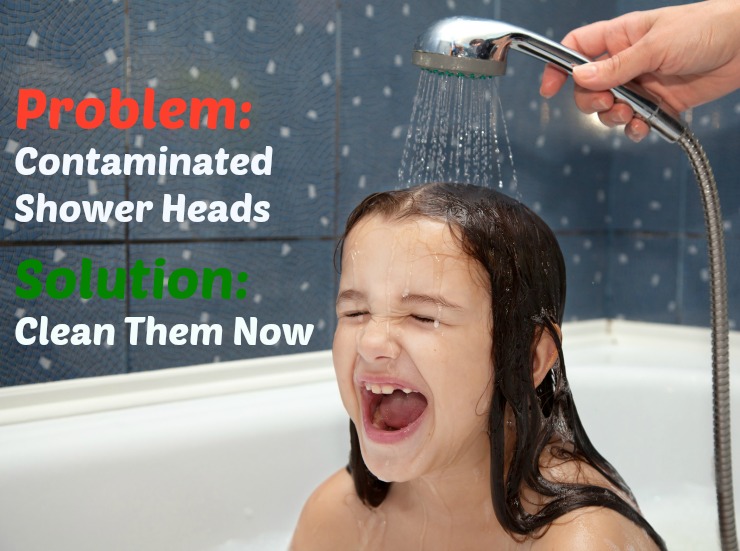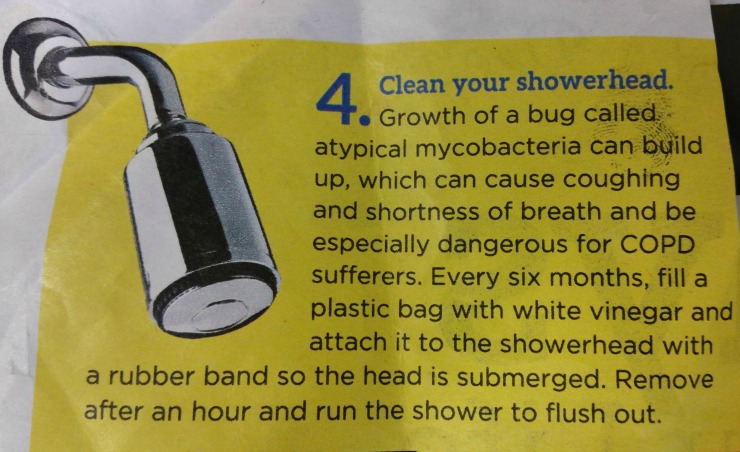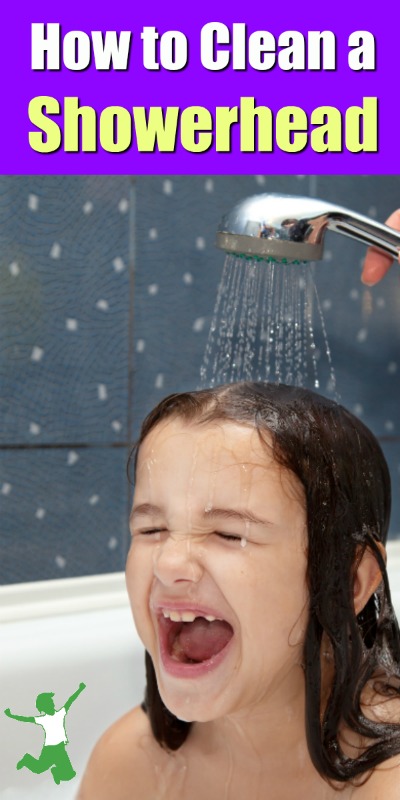One of the dirtiest things in the bathroom is the showerhead, which can get contaminated with an illness causing bacteria that is easily cleaned out with this simple method.
Did you know one of the dirtiest, most disgusting things in your entire home is the innocent looking shower head in your bathroom even if you use a water filter?
This is because shower filters are designed to remove chemicals like chlorine, not necessarily harmful microbes.
In fact, the typical shower head is probably far more contaminated with pathogenic bacteria than the toilet or sink in the same bathroom!
And to think many of us stand under it most days with water cascading over our heads and even straight into our open mouths if we prefer brushing our teeth while showering.
If this is news to you (it was to me!), you are definitely not alone…
Most people have no idea that a showerhead regardless of the model used is a favorite and very common breeding ground for a dangerous microbe that is on the rise.
Researchers call it atypical mycobacteria. But, no need to panic. You can fix the problem today and never worry about it again. Read on!
What is Atypical Mycobacteria?
Atypical mycobacteria are a very common group of microbes that surround us in the natural environment all the time. They are found in the water and soil. However, they can also be found in the air when they become aerosolized into droplets of water small enough to enter the tiny alveoli of the lungs such as what occurs during showering.
Despite being in the same family of bacteria as tuberculosis, atypical mycobacteria do not cause this deadly respiratory disease.
These pathogenic bacterial strains can, however, cause other types of serious health problems particularly when those exposed are already suffering from a weakened immune system or underlying illness. Atypical mycobacteria can cause infections of the skin, lungs, sinuses, lymph nodes, and other parts of the body.
Open wounds are particularly prone to infection from atypical mycobacteria. One species, M. paratuberculosis, is implicated in the development of Crohn’s disease (1).
On the positive side, person to person transmission of an infection with atypical mycobacteria does not occur with the exception of the strains that cause skin lesions. These include M. kansaii and M. simiae (2).
A Shower Head Full of Mycobacteria is a Health Hazard
Normal exposure to atypical mycobacteria in the environment would normally be in very small doses. In these natural situations, risk of infection is very small to nonexistent and would serve to boost immunity rather than cause infection.
However, when a shower head is contaminated with it, exposure can be frequent, intense, and completely overwhelming to the biological systems (3). This is especially true for young children whose immune systems are not yet fully developed.
Showering day after day with these pathogenic microbes pouring all over our skin, into our eyes, nose, and mouth is going to be a problem to our health, the only question is when.
All of us have days when our immune system is depressed for whatever reason. It could be a lack of sleep, an illness which has taken hold temporarily, or stressful family or work situations.
Symptoms of infection with atypical mycobacteria include coughing, breathing problems, and increased mucous production. Fever and overall weakness can present as well. Unexplained weight loss can also occur in extreme situations.
Solve Your Shower Head Issues TODAY
The best thing you can do to prevent atypical mycobacterial infections in yourself and your family is to treat the shower head like anything else in your bathroom: something that needs to be cleaned!
The showerhead cleaning process is simple, and you don’t have to do it that often. Every six months will do just fine!
Here’s what to do:
Shower Head Cleaning Protocol
Every six months, simply fill a sturdy plastic bag with distilled white vinegar (preferably nonGMO white vinegar … conventional is made from GMO corn!) and attach one to every shower head in your home. Large rubber bands can be used to secure the bags tightly.
If it’s easier, remove the showerhead completely and soak it in a bowl of vinegar.
Leave the showerhead soaking in the vinegar for an hour or longer. Do not reuse the bag or the vinegar for other showerheads in your home. In other words, use a fresh bag (or bowl) of vinegar for each shower head that needs to be disinfected.
Finally, remove the bags, dump the vinegar down the sink and run the shower heads to thoroughly flush them out.
Below is a helpful graphic of what to do that you can print out and stick on your refrigerator to remind you if that helps. Another idea is to schedule your twice per year showerhead cleanings at the same time you replace the batteries in your smoke alarms.
Thank you to Mark and Celeste of The Frank Clinic of Chiropractic for sharing this helpful graphic and green living tip that all of us can benefit from!

When I found out this information for the first time, I have to admit that I was more than a little grossed out! I immediately soaked our home’s showerheads as instructed.
Will you be doing the same?









Our deep well is contaminated with ecoli bacteria and we have flushed it 4 times with bleach, with no success. Do we need to clean our shower heads more often? We buy water for making coffee and cooking and use this water for bathing, washing clothes and dishes. My elderly mother has pulmonary fibrosis and has issues of itching lately. Could this be the cause.
Possibly so. I would suggest a consult with a water expert on that particular situation.
Thanks for another wonderful tip.
On a different subject, may I ask if you’re still using Green Pastures cod liver oil. I’m aware of the article you wrote when there was some question about the freshness and effectiveness of this product, and wondered if you continue to stand by the product.
Thanks again for all you’ve contributed to my healthy lifestyle.
Is the situation different with faucets? How about spray faucets? What makes the shower different?
The shower water is going over your head and body as well as in your eyes, nose and possibly mouth. The concentrated exposure would be very high. I would suggest that hand held spray faucets should be cleaned periodically also.
I read part of the problem also is that chlorine is put in the water for the bacteria but some bacteria has found a way for it to have no affect and it just encapsulates the chlorine , this opaque gooey stuff can be quite toxic , if I can find an article I-will link it
In order for atypical mycobacteria to appear inside a shower head, one would need to consider the source of where the atypical mycobacteria came from in the first place. Atypical mycobacteria isn’t an airborne pathogen, so it would be highly unlikely that atypical mycobacteria would establish a presence in a shower head, entering through the nozzles. More than likely, if atypical mycobacteria is present in your shower head, it could only be deduced that it is present in your entire plumbing system. Cleaning just the shower head effectively solves less than 1% of the problem.
With that said, the greatest risk of exposure is in your water heater. If atypical mycobacteria is present in your water, a water heater with a temp between 100*F-120*F would act as an incubator and atypical mycobacteria would flourish and colonize there. The best solution is to simply ensure your water heater setting is above 130*F.
Atypical mycobacteria is naturally in the water *and* the soil. We are exposed to it all the time, but in tiny usually insignificant amounts. The article doesn’t suggest that the bacteria comes from the air contact with the showerhead, but from the tap or well water itself even if it is not heated. It would be a risk and build up in showerheads even with the water heater at the proper setting. It would not likely build up in the plumbing as the pipes don’t have a place for the bacteria to lodge and grow into larger colonies that can concentrate exposure. The bacteria become airborne via the tiny water droplets that become aerosolized during the showering process.
This source linked to in the article explains it well. Having a higher water heater temperature can help, but doesn’t eliminate the problem: http://www.ncbi.nlm.nih.gov/pmc/articles/PMC3949190/
With these being microbes, I think you’d find many people who would disagree with the idea that bacteria have no place to lodge and grow into larger colonies, especially if there is any type of calcium buildup in the pipes (scaling). As much as you may hate to hear this, the most effective solution that rids most bacteria from any home on a daily basis, is chlorine that is added to the water entering your home.
If your plumbing is relatively clear of microbes and chlorine used in the water, cleaning the shower head would yield negligible results. That’s not to say people haven’t gotten sick from their plumbing. If your plumbing is such that you have significant buildup of bacteria in the shower head, it would mean you have significant amounts of bacteria throughout the plumbing. In such cases, cleaning the shower head only cleans 1% of the problem.
The shower is the only place you are cascaded with the microbes all over your body and they become airborne where you breathe them into the lungs. Concentrated exposure is the problem .. and this is what occurs during showering. Notice that bathing or washing your hands in a sink is not mentioned even if the hot water tank is not at the proper temperature.
I forgot to add that the article you linked only implicates the water heater as the source. It states the shower head simply allows the microbes, already in the water, to become airborne through the misting but does not implicate it as it does the water heater, where incubation can occur. Do you have a link to any articles that implicate the shower head itself?
Includes picture of a contaminated shower head. usatoday30.usatoday.com/tech/science/2009-09-14-showerhead-bacteria_N.htm
It also suggests not to clean them using bleach as this can actually make the problem worse.
Vinegar is effective for this purpose as it is acidic and destroys the microbial biofilm.
Thanks Sarah for posting this article, I’m thoroughly grossed out now! My husband does the vinegar ritual on a regular basis to keep our shower heads in good working condition but I never thought if them harboring such microbes. I wonder what pathology would loom on hotel shower heads…
What about drinking water from a faucet? I guess it can be contaminated too!
This is why it’s important to have a heavy duty filter at the tap where you get your drinking water that will filter microbes as well as chemical and organic contaminants. A shower filter is not robust enough to do the job. The ones I’ve seen just take out chlorine.
Thanks for posting this. What do you do if you have a filter on the shower – should you clean the head without the filter inside. So in other words take the filter out and then soak the head in the vinegar? Or soak the whole thing including the filter?
I would call the manufacturer and see what they suggest. My feeling is that removing the filter would be the way to go or to replace the filter twice a year when you soak the showerhead. My shower heads have filters also, but they are separate from the actual shower head so I soak it by itself.
Thanks for this tip. I usually just spray bleach on my shower head, but this is a much more natural solution. I like it much better. I’m going to have to try it – probably today! 🙂
Yucky! Thank you for the tip…I will be doing this tonight! I didn’t know you could get sick from not cleaning the shower head but it makes sense. I have a filter but still need to clean the shower head.
Sarah, how long would you run the shower to flush out after soaking?
I am guessing 5 minutes or the length of the average shower? I did not see any directions for how long, so just use your best judgment there.